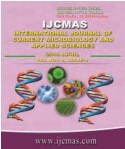


 National Academy of Agricultural Sciences (NAAS)
National Academy of Agricultural Sciences (NAAS)

|
PRINT ISSN : 2319-7692
Online ISSN : 2319-7706 Issues : 12 per year Publisher : Excellent Publishers Email : editorijcmas@gmail.com / submit@ijcmas.com Editor-in-chief: Dr.M.Prakash Index Copernicus ICV 2018: 95.39 NAAS RATING 2020: 5.38 |
A study on eco friendly management of Rice bug, Leptocorisa acutaunder upland rice by using organic pesticide was taken inOnattukara Regional Agricultural Research Station, Kayamkulam. Randomized block design with seven treatments and three replications were chosen which include 3 botanicals (1% azadirachtin 0.003%, cashew nut shell liquid 0.1% and dasagavya 3%), one microbial agent (chitin based Pseudomonas 2.5 kg ha-1), one animal origin pesticide (fish jaggery extract 0.6%) and one check insecticide (Malathion 50 EC 0.1%) and untreated control plot. The treatment dasagavya 3% showed the significant effect on reducing rice bug population as well as grain infestation throughout the reproductive stage of the crop. It recorded lowest grain damage of 8.75% significantly over other treatments. The mean population of rice bug was less and varies from 0.33-13 from treatment dasagavya 3%. As greater biodiversity present in upland rice, it showed non-toxic effect to natural enemies viz., predators, spiders and parasitoids. Untreated plot also recorded with more population of natural enemies. Malathion 50 EC 0.1% recorded least population of natural enemies and found to be toxic. Cashew nut shell liquid and Fish jaggery extract are also found to be effective and on par with Dasagavya. So, organic pesticides are safer and efficient in rice bug control under upland rice cultivation.
 |
 |
 |
 |
 |